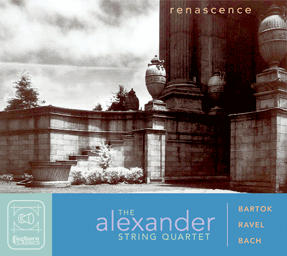renascence bartók, ravel, j.s. bach
ALEXANDER STRING QUARTET
FCL1984
“It’s by no means common to juxtapose a Bartók quartet with Ravel. Nor is it all that common to hear Mozart’s exploration of Bach in this context. The theory behind it, not one taken to didactic extremes I hasten to add, is that of ‘renascence’, the word chosen by sleeve-note writer Eric Bromberger to describe the process by which structural or cyclical themes are used in both the quartets and also to describe Mozart’s recasting into quartet form of a keyboard original.
— Jonathan Woolf, MusicWeb International, FCL 1984 Renascence
Excerpt from liner notes by Eric Bromberger
A beautiful combination of superb interpretations. Recorded at UC Davis Mondavi Center's legendary Jackson Hall, this recording captures the stunning soundscape of a great modern quartet firmly yet reflectively established in critical yet diverse repertoire.
The three works on this disc seem at first to have come from different planets, so disparate are they in character, but all three depend on the process of renascence: the transformation, re-birth, or re-use of material that was at first imagined in quite a different way. Such regeneration takes a range of forms here. In the Bartók quartet, it is structural — a theme that Bartók had imagined at first as a refrain proceeded to take over the music, transforming Bartók’s original structure into something quite different from what he had planned. In the Ravel quartet, the regeneration is cyclic — two fundamental theme-shapes presented in the first movement return in a variety of forms across the remaining three, becoming something new on each of their reappearances. The disc concludes with the work of two composers, a Bach fugue from The Well-Tempered Clavier, Book II, heard here in Mozart’s arrangement for string quartet. Bach’s fugue — itself a repetitive, regenerative form — is in this case re-cast by an admiring composer of a subsequent generation.
Legion of Honor — photography by Rory Earnshaw
The California Palace of the Legion of Honor, which was modeled on Pierre Rousseau’s Palais de la Legion d’Honneur in Paris, opened in San Francisco’s Lincoln Park in 1924. Home to a distinguished collection of Ancient and European art, the Palace is dedicated to the memory of the 3600 Californians who were killed in France during World War I. Its imposing entrance is guarded by a magnificent pair of stone lions. Rory Earnshaw’s photos of one of these lions and an adjacent horse were shot at night in a time exposure using only ambient light. www.roryearnshawmonochrome.com
More Bartók
Order Now
ORDER NOW
• • •
TRACK LISTING
BÉLA BARTÓK (1881–1945)
String Quartet No. 6, Sz. 114
1. Mesto–Più mosso, pesante–Vivace
2. Mesto–Marcia
3. Mesto–Burletta: Moderato
4. Mesto
MAURICE RAVEL (1875–1937)
String Quartet in F
5. Allegro moderato
6. Assez vif — Très rythmé
7. Très lent
8. Vif et agité
JOHANN SEBASTIAN BACH (1685–1750)
Well-Tempered Clavier, Book II (arr. Mozart)
9. Fugue No. 7 in E-flat Major, BWV 876
More Bartók
